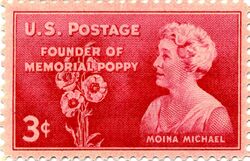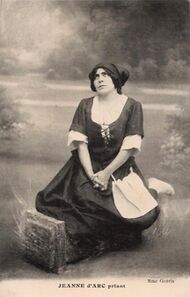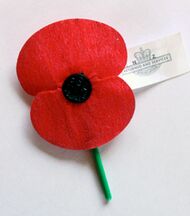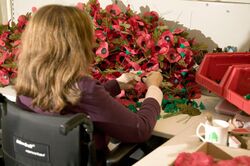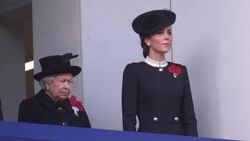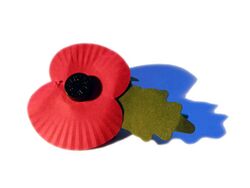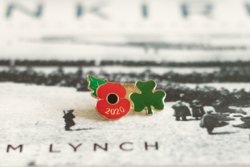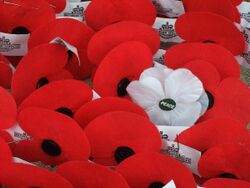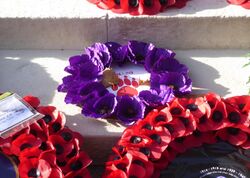Biology:Remembrance poppy
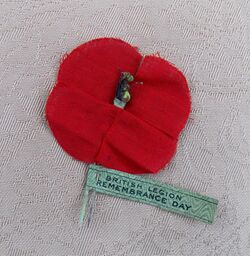
The remembrance poppy is an artificial flower worn in some countries to commemorate their military personnel who died in war. Veterans' associations exchange poppies for charitable donations used to give financial, social and emotional support to members and veterans of the armed forces.[2]
Inspired by the war poem "In Flanders Fields", and promoted by Moina Michael, they were first used near the end of World War I to commemorate British Empire and United States military casualties of the war. Madame Guérin established the first "Poppy Days" to raise funds for veterans, widows, orphans, liberty bonds, and charities such as the Red Cross.[1]
Today, the remembrance poppy is mainly used in the United Kingdom and the Commonwealth, where it has been trademarked by veterans' associations for fundraising. In these countries, small remembrance poppies are often worn on clothing leading up to Remembrance Day/Armistice Day,[3] and poppy wreaths are often laid at war memorials. In Australia and New Zealand, they are also worn on Anzac Day.[4]
The Royal British Legion's Poppy Appeal has caused controversy in recent decades, with some—including British Army veterans—arguing that the symbol has been used excessively to marshal support for British military interventions and that public figures have been pressured to wear the poppies.[5]
Origins
The opening lines of the World War I poem "In Flanders Fields" refer to poppies growing among the graves of war victims in a region of Belgium. The poem is written from the point of view of the fallen soldiers and in its last verse, the soldiers call on the living to continue the conflict.[6] The poem was written by Canada physician John McCrae on 3 May 1915 after witnessing the death of his friend and fellow soldier the day before. The poem was first published on 8 December 1915 in the London-based magazine Punch.
Moina Michael, who had taken leave from her professorship at the University of Georgia to be a volunteer worker for the American YMCA Overseas War Secretaries Organization, was inspired by the poem. She published a poem of her own called "We Shall Keep the Faith" in 1918.[7] In tribute to McCrae's poem, she vowed to always wear a red poppy as a symbol of remembrance for those who fought in and assisted with the war.[8] At a November 1918 YMCA Overseas War Secretaries' conference, she appeared with a silk poppy pinned to her coat and distributed twenty-five more poppies to attendees. She then campaigned to have the poppy adopted as a national symbol of remembrance.
At its conference in 1920, the National American Legion adopted the poppy as their official symbol of remembrance.[8] Frenchwoman Madame Guérin[1] was invited to address American Legion delegates at their 1920 Cleveland Convention about 'Inter-Allied Poppy Day.' After the convention, the American Legion too adopted the poppy as its memorial flower and committed to support Madame Guérin in her planned U.S. Poppy Day. It was also following this event that the American Legion christened Madame Guérin as "The Poppy Lady from France." Madame Guérin successfully organized the U.S.'s first nationwide Poppy Day during the week before Memorial Day in May 1921 using silk poppies made by the widows and children of the devastated regions of France.[1]
When the American Legion stopped using the poppy symbol in favor of the daisy, Veterans of Foreign Wars' members supported Madame Guérin instead. Using French-made poppies purchased through her, the V.F.W. organized the first veterans' Poppy Day Drive in the US, for the 1922 Memorial Day.[1] In 1924, the Veterans of Foreign Wars patented the Buddy Poppy.[9]
Madame Guérin's 'Inter-Allied Poppy Day' idea was also adopted by military veterans' groups in parts of the British Empire. After the 1921 Memorial Day in the US, Madame Guérin traveled to Canada. After she addressed the Great War Veteran Association on 4 July, the group also adopted the poppy emblem as well as 'Inter-Allied Poppy Day' concept. They were the first veterans of the British Empire (predecessor of the Commonwealth of Nations) to do so.[1]
Madame Guérin sent Colonel Moffat (ex-American Red Cross) to Australia and New Zealand (and probably South Africa) afterwards as her representative. She then traveled to Great Britain, where she informed Field Marshal Douglas Haig and the Royal British Legion about her idea. Because it was an underfunded organization, Madame Guérin paid for the British remembrance poppies herself and the British Legion reimbursed her after the first British Remembrance Day Poppy Day on 11 November 1921.[1]
James Fox notes that all of the countries which adopted the Remembrance Poppy were victors of World War I.[6]
An early reference to war and poppies in Flanders is found in the book The Scottish Soldiers of Fortune by James Grant:
The Scots in Holland and Flanders: At Neerwinden, in 1693, the brigade again suffered heavy loss, and William was compelled again to give way before the white-coated infantry of France with the loss of 10,000 men. "During many months after," wrote the Earl of Perth to his sister (as quoted by Macaulay), "the ground was strewn with skulls and bones of horses and men, and with fragments of hats, shoes, saddles, and holsters. The next summer the soil, fertilised by 20,000 corpses, broke forth into millions of scarlet poppies."[10]
Usage
Remembrance poppies are mostly used in Australia, Canada, New Zealand, and the United Kingdom—all of which are realms of the Commonwealth of Nations—to commemorate the servicemen and women killed in conflict. They are used to a much lesser extent in the United States .
Australia
In Australia, the Flanders Poppy (remembrance poppies) has been used since 1921 to commemorate Australian soldiers who died in war. On Remembrance Day (11 November) and Anzac Day (25 April), poppies are laid at war memorials and are sold by the Returned and Services League of Australia (RSL) to raise funds.[11] Military folklore indicates that the vivid red of the poppies symbolise their comrades' blood soaking into the battleground.[12]
Canada
In Canada, the poppy is the official symbol of remembrance. It was adopted as such in 1921 and it is generally worn during the two weeks leading up to 11 November. The Royal Canadian Legion, which has trademarked the image,[13] suggests that poppies be worn on the left lapel, or as near the heart as possible.[14]
Poppies are traditionally removed at the conclusion of the Remembrance Day ceremony and placed on or near the cenotaph. Until 1996, poppies were made by disabled veterans in Canada, but they have since been made by a private contractor.[15] The Canadian poppies consist of two pieces of moulded plastic covered with flocking with a pin for fastening to clothing. The poppies were initially made with a black centre. From 1980 to 2002, the centres were changed to green. Current designs are black only; this change confused those unfamiliar with the original design.[16] In 2007, poppy stickers were introduced for children, the elderly, and healthcare and food industry workers.[17]
Canada also issues a cast metal "Canada Remembers" pin featuring a gold maple leaf and two poppies, one representing the fallen and the other representing those who remained on the home front.[18]
Following the 2000 installation of the Tomb of the Unknown Soldier at the National War Memorial in Ottawa, where the national Remembrance Service is held, a new tradition began of attendees laying their poppies on the tomb at the end of the service. While not part of the official program, the act has become widely practised elsewhere in the country, with others leaving cut flowers, photographs, or letters as well.
Since introduction to Canada in 1949, the Remembrance Poppy and Armistice Day commemorations have largely displaced Newfoundland's own commemorative floral emblem, the forget-me-not, as well as the province's Memorial Day held on 1 July. Although in recent years the forget-me-not has had somewhat of a resurgence in Newfoundland's military commemorations,[19][20] the Remembrance Poppy remains more common.
New Zealand
In New Zealand, Remembrance Poppies are most often worn on Anzac Day (April 25) to commemorate New Zealand soldiers who died in war. They are also worn on Remembrance Day, and are sold by the Royal New Zealand Returned and Services' Association (RSA) to raise funds. The RSA planned to hold its first Poppy Day appeal around the time of Armistice Day 1921, as other countries were doing, but the ship carrying the poppies from France arrived in New Zealand too late. The association therefore waited until Anzac Day 1922.[citation needed] This first Poppy Day appeal was a success. Most of the money raised went to needy soldiers and their families, while the rest went to the French Children's League to help relieve suffering in war-ravaged areas of northern France.[citation needed]
Following its introduction, the popularity of Poppy Day grew and there were record collections during World War II. By 1945, 750,000 poppies were distributed nationwide, an amount equal to half the country's population.[21]
United Kingdom
In the United Kingdom, Remembrance Poppies are sold by The Royal British Legion (RBL), a charity providing financial, social, political, and emotional support to those who have served or are currently serving in the British Armed Forces and their dependents. They are sold on the streets by volunteers in the weeks before Remembrance Day. The Remembrance Poppy is the trademark of The Royal British Legion.[22][23] The RBL states, "The red poppy is our registered mark and its only lawful use is to raise funds for the Poppy Appeal,"[24] its yearly fundraising drive in the weeks before Remembrance Day. The organization says these poppies are "worn to commemorate the sacrifices of our Armed Forces and to show support to those still serving today."[25] Other poppy merchandise is sold throughout the year as part of ongoing fundraising.[26]
In England, Wales, and Northern Ireland, the poppies typically have two red paper petals mounted on a green plastic stem with a single green paper leaf and a prominent black plastic central boss. The stem has an additional branch used as a pin to anchor the poppy in the lapel or buttonhole. In Scotland, the poppies are curled and have four petals with no leaf. The yearly sale of poppies is a major source of income for the RBL in the UK. The poppy has no fixed price; it is sold for a donation or the price may be suggested by the seller. The black plastic centre of the poppy was marked "Haig Fund" until 1994 but is now marked "Poppy Appeal."[27]
A team of about 50 people—primarily disabled former British military personnel—work year round to assemble millions of poppies at the Poppy Factory in Richmond.[28] Scottish poppies are made in the Lady Haig's Poppy Factory in Edinburgh.
For years after World War I, poppies were worn only on Remembrance Day.[29] Today the RBL's "Poppy Appeal" has a higher profile than other charity appeals in the UK.[29] The pins are widespread from late October until mid-November every year and are worn by the general public, politicians, the Royal Family and other public figures. It has become common to see large poppies on buses, tube trains and airplanes, as well as on lampposts, billboards, public buildings, and landmarks. Many newspapers and magazines show a poppy on their cover page, and some social network users add poppies to their avatars.[citation needed] Each year, an official Poppy Appeal single has been released.[30] Remembrance Poppy sellers are found on streets and at numerous public events such as concerts, fairs, marathons and competitions. Other awareness raising events have initiated. For example, in 2011, a Second World War aeroplane dropped 6,000 poppies over the town of Yeovil in Somerset.[31] In 2014, Blood Swept Lands and Seas of Red, a public art installation was created in the dry moat of the Tower of London by covering it with 888,246 ceramic poppies – one for each soldier of the British Empire killed in World War I.
In 1997 and again in 2000 the Royal British Legion registered the Poppy under Intellectual Property Rights[32] and Trade Mark.[33]
Northern Ireland
The Royal British Legion also holds a yearly poppy appeal in Northern Ireland and in 2009 raised more than £1m.[34] The wearing of poppies in Northern Ireland is controversial.[6] It is seen by many as a political symbol[6][35] and a symbol of Britishness,[6][36][37] representing support for the British Army.[35] The poppy has long been the preserve of the unionist/loyalist community.[6][36] Loyalist paramilitaries (such as the UVF and UDA) have also used poppies to commemorate their own members who were killed in The Troubles.[38]
Most Irish nationalists and republicans choose not to wear poppies;[35] they regard the Poppy Appeal as supporting soldiers who killed civilians (for example on Bloody Sunday) or colluded with illegal loyalist paramilitaries (for example the Glenanne gang) during The Troubles.[6][39][40][41][42][43] Irish nationalist groups, and victims' groups, have urged the BBC to end its policy that all presenters must wear poppies. They argue that it breaches impartiality and points out that political symbols are banned in workplaces in Northern Ireland. They also say that the BBC, as a publicly funded body, should broadly reflect the whole community.[41][44] Likewise, the director of Relatives for Justice has condemned the wearing of poppies by police officers in Catholic neighbourhoods, calling it "repugnant and offensive to the vast majority of people within our community, given the role of the British Army".[40] In the Irish Independent, it was claimed that "substantial amounts" of money raised from selling poppies are used "to build monuments to insane or inane generals or build old boys' clubs for the war elite".[42] On Remembrance Day 2010 the SDLP's Margaret Ritchie was the first leader of a nationalist party to wear one.[45]
Republic of Ireland
During World War I, all of Ireland was part of the United Kingdom and about 200,000 Irishmen fought in the British Army (see Ireland and World War I). During World War II, some 70,000 citizens of the then-independent state of Ireland served in the British armed forces, and a Roll of Honour in Trinity College Dublin lists 3,617 people from the Republic who died on active service in the war.[46][47] Although the British Army is banned from actively recruiting in the Republic of Ireland,[48][49] the RBL has a branch in the Republic and holds a wreath-laying ceremony at St Patrick's Cathedral, Dublin, which the President of Ireland has attended.[50]
The Republic has its own National Day of Commemoration in July for all Irish people who died in war. As in other non-Commonwealth countries, poppies are not often worn and are not part of the main commemorations.[51][52] This is partly due to the British Army's role in fighting against Irish independence, some of its actions during the War of Independence[53] and its role in Northern Ireland during the Troubles.
In the years following the War of Independence, the poppy was particularly controversial, with Irish nationalists seeing it as a provocative symbol of British imperialism. In Dublin, British Legion marchers often had poppies snatched from their lapels, which led to street fights. In response, some poppy-wearers hid razor blades in their poppies.[54][55] "As the 1930s progressed, 'Poppy Day' lost much of its violent edge in Dublin, but the wearing of the symbol also became less commonplace in subsequent decades".[56]
In 2017, Taoiseach Leo Varadkar wore a "shamrock poppy" in the Dáil, the first Taoiseach to do so.[57]
United States
In the United States, the Veterans of Foreign Wars conducted the first nationwide distribution of remembrance poppies before Memorial Day in 1922.[58] Today, the American Legion Auxiliary distributes crepe-paper poppies in exchange for donations around Memorial Day and Veterans Day.[59][60][61]
Hong Kong
In Hong Kong—which was formerly a British colony—the poppy is worn by some participants on Remembrance Sunday each year.[62][63] It is not generally worn by the public, although The Royal British Legion's Hong Kong and China Branch sells poppies to the public in a few places in Hong Kong only.[64]
Ukraine
Since 2014, Ukraine have worn the poppy as a symbol of the Victory over Nazism and commemoration of the victims of World War II. It has largely replaced the Ribbon of Saint George, which became associated with pro-Russian separatists and Russian military aggression. A poppy logo was designed by Serhiy Mishakin and contains the text: "1939-1945 Never Again".[65]
Pakistan
In parts of Pakistan , the 'Great War Company' holds a private ceremony each 11 November where red poppies are worn, by descendants of World War I veterans from the old British Indian Army.[66]
Albania
In Albania, government representatives, including Prime Minister Edi Rama, wore the Remembrance Poppy during the commemoration ceremonies for the 70th Anniversary of the Liberation of Albania.[67]
Other designs and purposes
White poppies
Some people choose to wear white poppies as an alternative to the red poppy. The white poppy and white poppy wreaths were introduced by Britain's Co-operative Women's Guild in 1933.[68] Today, white poppies are sold by Peace Pledge Union or may be home-made.[27] The white poppy may be worn alone or alongside the red poppy. According to the Peace Pledge Union, it symbolises remembrance of all casualties of war including civilian casualties, and non-British casualties, to stand for peace, and not to glamorise war.[69] Some women in the 1930s lost their jobs for wearing white poppies, and today the controversy remains where white poppies are criticised for detracting from the meaning and the funds of the red poppy.[70]
Purple poppies
To commemorate animal victims of war, Animal Aid in Britain has issued a purple remembrance poppy, which can be worn alongside the traditional red one, as a reminder that both humans and animals have been – and continue to be – victims of war.[71][72] Recently, the purple poppy was replaced by a purple paw symbol that can be worn all year round. This was because people saw the poppy as implying animals had given their lives as heroes in the service of human beings. Animal Aid regards animals of having their lives taken by the abuse of humans in war, not given by the animals as could be the case with people who have the capacity to decide for themselves.[73]
Black poppies
On Remembrance Sunday 1999, a Merseyside group protesting against sanctions and war on Iraq laid a wreath of black poppies on the cenotaph in Liverpool.[74] In 2014 the black poppy was embraced as an anti-war symbol by the Stop the War Coalition which reported 'anti militarists' in Glasgow distributing 16,000 black poppies in memory of World War I conscientious objectors.[75]
Khadi poppies
Introduced in the 2018 Centenary year by Jitesh Gadhia and The Royal British Legion, the khadi poppy is intended to represent specific gratitude for the contribution of 1.5 million people from undivided India, as well as Commonwealth nations more generally, to the First World War. These poppies are identical to the Legion red poppy except the petals are made of khadi, a spun cotton cloth popularised by Mahatma Gandhi on his spinning wheel.[76] Jitesh Gadhia has stated that "the khadi poppy is a hugely symbolic and highly appropriate gesture to recognise the outsized contribution of Indian soldiers during WWI."[77] On the poppy's role to reach out to ethnic minority communities whose ancestors participated in the war effort, he said that "our identity is our destiny – and so the current generation of Asians should know that their fathers and grandfathers didn't just come to Britain as immigrants. Our ancestors fought for this country and for freedom and democracy – even though they lived in a colony at the time...British Asians should be proud of the role that their forebears played in shaping the destiny of the world."[citation needed]
It has been worn by British Prime Minister Theresa May, and by cricketers Joe Root and Virat Kohli before a test match between England and India in September 2018.[78][79]
Rainbow poppies
In 2019, a listing appeared on eBay in the United Kingdom selling rainbow poppies.
The Royal British Legion confirmed that the Rainbow Poppy was not an officially endorsed product. While the eBay listing stated that the money raised by sales of the rainbow poppy would "go towards helping charity", it was not clear which charities would benefit from sales.[80] This led to widespread criticism online, with some accusing the seller of "hijacking" the poppy appeal. Brexit Party candidate Nicholas Goulding argued the poppy was "not for political controversy". Supporters of the poppy responded by tweeting Goulding examples of famous LGBTQ people who had played a significant role in previous conflicts, such as Alan Turing.[81]
The listing was subsequently removed by the original user, due to negative feedback.[82]
Protests and controversy
In 1993, The Royal British Legion complained that Cannon Fodder, a video game with an anti-war message, had planned to use a poppy on its cover. The Legion, along with some politicians, called it "offensive to millions" and "monstrous". The publisher was forced to change the cover before the game was released.[citation needed]
Within the United Kingdom, there has been growing controversy over the Poppy Appeal. Some—including a few British Army veterans—have argued that the Poppy Appeal has become excessive, that it has been used to marshal support for British military activities, and that poppy wearing has become seen as compulsory for public figures.[5][83] In 2006, Channel 4 newsreader Jon Snow described the pressure to wear a poppy as "poppy fascism".[84] Columnist Dan O'Neill wrote in 2011 that "presenters and politicians seem to compete in a race to be first – poppies start sprouting in mid-October while the absence of a poppy is interpreted as absence of concern for the war dead, almost as an unpatriotic act of treachery."[85] Likewise, Jonathan Bartley of the religious think-tank Ekklesia said "Public figures in Britain are urged, indeed in many cases, required, to wear ... the red poppy, almost as an article of faith. There is a political correctness about the red poppy."[86] Journalist Robert Fisk complained in 2011 that the poppy had become a seasonal "fashion accessory" and that people were "ostentatiously wearing a poppy for social or work-related reasons, to look patriotic when it suited them."[87]
In 2010, a small group of British Army veterans issued an open letter complaining that the Poppy Appeal had become excessive and garish, that it was being used to marshal support behind British military interventions, and that people were being pressured into wearing poppies.[5] In 2014, the same group protested by holding an alternative remembrance service: they walked to The Cenotaph under the banner "Never Again" with a wreath of white poppies to acknowledge civilians killed in war. Their tops bore the message "War is Organised Murder", a quote from Harry Patch, one of the last surviving veterans of World War I.[88][89]
A 2010 Remembrance Day ceremony in London was disrupted by members of the Muslims Against Crusades group, who were protesting against the British military presence in Afghanistan and Iraq. They burnt large poppies and chanted "British soldiers burn in hell" during the two-minute silence. Two of the men were arrested and charged for threatening behavior. One was convicted and fined £50.[90] The same group planned to hold another protest in 2011, but was banned by the Home Secretary the day before the planned protest.[91] In 2014, a campaign was begun to encourage Muslim women to wear poppy hijabs. Some criticised it as a "shrouded loyalty test" which implied that Muslims needed to prove their loyalty to Britain.[92][93][94] Controversially, some far-right groups have used the poppy as a symbol of militant British nationalism, while some British Muslims have begun to reject it, seeing the poppy as a "symbol of Western imperialism".[6]
In November 2011, people were arrested in Northern Ireland after a picture of two youths burning a poppy was posted on Facebook. The picture was reported to police by a member of the RBL.[95] The following year, a young Canterbury man was arrested for allegedly posting a picture of a burning poppy on Facebook, on suspicion of an offence under the Malicious Communications Act.[96]
British Prime Minister David Cameron rejected a request from Chinese officials to remove his poppy during his visit to Beijing on Remembrance Day in 2010. The poppy was deemed offensive because it was mistakenly assumed to be connected with First and Second Opium Wars of the 19th century.[97]
In 2012, there was controversy when The Northern Whig public house in Belfast refused entry to a man wearing a remembrance poppy.[98] Although the owners apologised, the customer took the matter to court, supported by the Equality Commission for Northern Ireland (ECNI).[99] The case was significant for the decision supporting the view of the ECNI that "The poppy, although not directly linked to a specific religious belief or political opinion, would historically have been associated to a greater extent with the Protestant or unionist community in Northern Ireland".[100]
In 2018, The Independent reported that both the Royal British Legion and Lady Haig's Poppy Factory had, since 2015, held contracts with One3One Solutions, the commercial arm of the Ministry of Justice, for prisoners at HM Prison Ford to manufacture the plastic central button and green stem of the poppies, for which they earned on average £10 a week. The RBL also confirmed that it had a contract with HM Prison Whitemoor for the refurbishment by inmates of its collecting tins, buckets, trays and boxes.[101] The revelation of the involvement of inmate labour in the production of British and Scottish Remembrance Poppies sparked controversy, with the executive director of the charity War on Want describing it as the "exploitation of cheap labour",[101] and Faith Spear, former member of the Independent Monitoring Board at Hollesey Bay prison, describing the repetitive and unskilled manual labour typically involved in prison labour as "mind numbing" and "akin to mental torture".[102]
In the media
In the British media, public figures have been attacked for not wearing poppies. British journalist and newsreader Charlene White has faced racist and sexist abuse for not wearing a poppy on-screen. She explained "I prefer to be neutral and impartial on screen so that one of those charities doesn't feel less favoured than another".[103] Newsreader Jon Snow does not wear a poppy on-screen for similar reasons. He too was criticised and he condemned what he saw as "poppy fascism".[104] Well-known war-time journalist Robert Fisk published in November 2011 a personal account about the shifting nature of wearing a poppy, titled "Do those who flaunt the poppy on their lapels know that they mock the war dead?".[105] While all newsreaders in the UK are expected to wear the remembrance poppy, those on the BBC World News service are told not to. The BBC say this is because the symbol is not widely recognised overseas. The Royal British Legion condemned this, insisting that the poppy is the "international symbol of remembrance".[106]
Fabrizio De André, an Italian songwriter known for his sympathies towards anarchism, left-libertarianism and pacifism, featured red poppies in his song, 'Piero's war', about the death of a soldier, inspired the poem 'Le Dormeur du val' of Arthur Rimbaud:
You sleep buried in a field of wheat
it is neither the rose nor the tulip
who watch over you from the shadow of ditches,
but it is a thousand red poppies.
In a November 2020 episode of Jeremy Vine, activist Femi Oluwole questioned why BBC presenters were still permitted to wear poppies, following new impartiality guidance warning against "virtue signalling, no matter how worthy the cause", which had previously prevented staff from expressing support for Black Lives Matter and LGBT rights.[107]
In sport
In the run-up to Remembrance Day, it has become common for UK football teams to play with artificial poppies sewn to their shirts, at the request of the Royal British Legion. This has caused some controversy.
At a Celtic v Aberdeen match in November 2010, a group of Celtic supporters, called the Green Brigade, unfurled a large banner in protest at the team wearing poppies. In a statement, it said: "Our group and many within the Celtic support do not recognise the British Armed Forces as heroes, nor their role in many conflicts as one worthy of our remembrance". It gave Operation Banner (Northern Ireland), the Afghanistan War and the Iraq War as examples.[108]
Northern Irish–born footballer James McClean, who has played for several English teams, has received death threats and abuse since 2012 for refusing to wear a poppy on his shirt during matches.[109] McClean said he does not wear one because the Poppy Appeal supports British soldiers who served in Northern Ireland, and believes it would disrespect those killed in his hometown on Bloody Sunday.[110]
In November 2011, it was proposed that the England football team should wear poppies on their shirts in a match against Spain. FIFA turned down the proposal; their decision was attacked by Prince William.[111] FIFA subsequently allowed the English, Scottish and Welsh teams to wear poppies on black armbands.[112]
On 11 November 2017, the third day of the Women's Test match held at North Sydney Oval as part of the Women's Ashes 2017–18, both the Australian and the English team players wore poppies to mark 99 years since the end of World War I.[113]
During the 2018 FIFA World Cup Qualifiers, the England, Scotland, Wales and Northern Ireland football teams were fined for displaying the poppy during matches. FIFA rules forbid the display of "political or religious symbols".[114][115][116] The decision was strongly criticised by Prime Minister Theresa May, and the Welsh and English football associations appealed against the fine, with the English Football Association threatening to bring the matter to the Court of Arbitration for Sport.[116][117][118]
In November 2018, Manchester United's Serbian midfielder Nemanja Matić refused to wear a poppy on his shirt for a match against Bournemouth.[119] After the match, Matić was castigated and received threats from a number of people via social media.[120] Matić stated that he would not wear a poppy because his village of Vrelo was hit by the NATO bombing of Yugoslavia in 1999.[119]
In ice hockey, players and coaches traditionally wear a poppy, with players often featuring a poppy decal on their helmets. Even outside Canada and the Commonwealth (especially in the United States), hockey clubs will often feature the poppy in November because of the sport's Canadian heritage and the typical presence of Canadian team members.[121]
See also
- Bleuet de France – the cornflower of France, the French equivalent of the remembrance poppy
- The Red Poppies on Monte Cassino – in Polish tradition, poppies used as a remembrance symbol of the Battle of Monte Cassino
References
- ↑ 1.0 1.1 1.2 1.3 1.4 1.5 1.6 Johnson, Heather. "Madame Guérin" (in en). https://poppyladymadameguerin.wordpress.com/.
- ↑ "Remembrance Day: Why do people wear poppies?". Newsround (BBC). 2019-11-10. https://www.bbc.co.uk/newsround/15492228.
- ↑ Rahman, Rema (9 November 2011). "Who, What, Why: Which countries wear poppies?". BBC News. https://www.bbc.com/news/magazine-15637074.
- ↑ "What is Anzac Day?" (in en). 2019-08-08. http://www.army.mil.nz/culture-and-history/anzac-day.htm.
- ↑ 5.0 5.1 5.2 Bates, Stephen (5 November 2010). "Poppy appeal's original aims being subverted, veterans complain". The Guardian. https://www.theguardian.com/uk/2010/nov/05/poppy-appeal-subverted-veterans-complain.
- ↑ 6.0 6.1 6.2 6.3 6.4 6.5 6.6 6.7 Fox, James (2014). "Poppy Politics: Remembrance of Things Present". in Sandis, Constantine. Poppy Politics: Remembrance of Things Present. Open Book Publishers. pp. 23–28. ISBN 978-1-78374-067-3.
- ↑ "Moina Michael". Georgia Info. Digital Library of Georgia. http://georgiainfo.galileo.usg.edu/mmichael.htm.
- ↑ 8.0 8.1 "Where did the idea to sell poppies come from?". BBC News. 10 November 2006. http://news.bbc.co.uk/1/hi/magazine/6133312.stm.
- ↑ "Poppy Day" (in en-US). Green Township Veterans of Foreign Wars - Post 10380. https://www.vfw10380.org/poppy-day/.
- ↑ Grant, James (1889). The Scottish Soldiers of Fortune: Their Adventures and Achievements in the Armies of Europe. London: G. Routledge. p. 161. OCLC 222216153.
- ↑ "Our Heritage: Traditions: The Red Poppy". The Australian Army. https://www.army.gov.au/our-heritage/traditions/red-poppy.
- ↑ "Red poppies" (in en). The Australian War Memorial. https://www.awm.gov.au/commemoration/customs-and-ceremony/poppies.
- ↑ "The Poppy trademark". The Royal Canadian Legion. https://www.legion.ca/remembrance/the-poppy/the-poppy-trademark.
- ↑ "10 Quick Facts on... The Poppy". Veterans Affairs Canada. 14 February 2019. https://www.veterans.gc.ca/eng/remembrance/information-for/educators/quick-facts/poppy.
- ↑ "The Poppy Campaign". The Royal Canadian Legion. http://www.legion.ca/Poppy/campaign_e.cfm.
- ↑ Marion, MWO Normand (2002-11-06). "Green or Black, It's Still The Poppy!". Royal Canadian Air Force. http://www.rcaf-arc.forces.gc.ca/16w-16e/nr-sp/index-eng.asp?id=180.
- ↑ Skikavich, Julia (5 November 2008). "New sticker poppies are catching on". CBC News. https://www.cbc.ca/news/canada/new-sticker-poppies-are-catching-on-1.739963.
- ↑ "Canada Remembers Program Policy Manual". Veterans Affairs Canada. 2009. https://docs.google.com/leaf?id=0B3nMfjn73O0gOWE2NDkxMGQtYTRjOS00ZDE0LTk5ZDMtOWRlNGRmY2U0ODY2&sort=name&layout=list&pid=0B3nMfjn73O0gYzNkZGFiODktYTA4Ny00MTAxLWFkOTgtZDE3OTQ2MDk0ZTYx&cindex=18.
- ↑ "Special Forget-Me-Nots". The Telegram (St. John's, Newfoundland and Labrador). 2016-06-22. http://www.thetelegram.com/News/Local/2016-06-22/article-4567810/Special-Forget-Me-Nots/1.
- ↑ "Legion members given go-ahead to wear forget-me-nots in 2016". CBC News. 2015-12-13. http://www.cbc.ca/news/canada/newfoundland-labrador/forget-me-not-newfoundland-legion-beaumont-hamel-1.3360692.
- ↑ "Anzac Day: The red poppy". New Zealand History. New Zealand Ministry for Culture and Heritage. http://www.nzhistory.net.nz/war/anzac-day/poppies.
- ↑ "Trade mark number EU000681452". United Kingdom Intellectual Property Office. https://trademarks.ipo.gov.uk/ipo-tmcase/page/Results/4/EU000681452.
- ↑ "Trade mark number EU004066271". United Kingdom Intellectual Property Office. https://trademarks.ipo.gov.uk/ipo-tmcase/page/Results/4/EU004066271.
- ↑ "Wiltshire woman's poppy teardrop 'violates trademark'". BBC News. 9 November 2011. https://www.bbc.com/news/uk-england-wiltshire-15654558.
- ↑ "Poppy Appeal 2014". The Royal British Legion. http://www.britishlegion.org.uk/get-involved/poppy-appeal.
- ↑ "Poppy Shop UK". The Royal British Legion. http://www.poppyshop.org.uk/.
- ↑ 27.0 27.1 "White Poppies are for Peace". Peace Pledge Union. http://www.ppu.org.uk/whitepoppy/index.html.
- ↑ "The Poppy Factory". The Royal British Legion. https://www.poppyfactory.org/poppies/.
- ↑ 29.0 29.1 "Letters to the Daily Telegraph". The Daily Telegraph (London). 11 November 2006. https://www.telegraph.co.uk/comment/letters/3634134/Letters-to-the-Daily-Telegraph.html.
- ↑ Sherwin, Adam (7 November 2014). "Joss Stone criticised for sentimentalising famed anti-war song for Poppy Appeal". The Independent. https://www.independent.co.uk/arts-entertainment/music/news/joss-stone-criticised-over-sentimentalising-famed-anti-war-song-for-poppy-appeal-9847312.html.
- ↑ "WWII plane drops poppies over Yeovil". BBC News. 29 October 2011. https://www.bbc.co.uk/news/uk-england-somerset-15507929.
- ↑ "Trade mark number EU000557058". United Kingdom Intellectual Property Office. https://trademarks.ipo.gov.uk/ipo-tmcase/page/Results/4/EU000557058.
- ↑ "Trade mark number UK00002239583". United Kingdom Intellectual Property Office. https://trademarks.ipo.gov.uk/ipo-tmcase/page/Results/1/UK00002239583.
- ↑ "Poppy Appeal in Northern Ireland breaks £1m barrier". Belfast Telegraph. 23 December 2009. https://www.belfasttelegraph.co.uk/breakingnews/breakingnews_ukandireland/poppy-appeal-in-northern-ireland-breaks-1m-barrier-28507746.html.
- ↑ 35.0 35.1 35.2 Smyth, Lisa (7 November 2009). "Thousands gather to remember war dead". Belfast Telegraph. https://www.belfasttelegraph.co.uk/news/thousands-gather-to-remember-war-dead-28502427.html.
- ↑ 36.0 36.1 "Symbols used in Northern Ireland: Unionist and loyalist symbols". Conflict Archive on the Internet (CAIN). http://cain.ulst.ac.uk/images/symbols/unionloyal.htm.
- ↑ "Adams apologises for Enniskillen bombing". BBC News. 8 November 1997. http://news.bbc.co.uk/1/hi/uk/25480.stm.
- ↑ Bort, Eberhard (2004). Commemorating Ireland: History, politics, culture. Dublin: Irish Academic Press. p. 65. ISBN 978-0-7165-2768-8.
- ↑ Rodgers, Suzanne (12 November 2007). "Maybe it's time for a green poppy instead". Derry Journal. https://www.derryjournal.com/news/opinion/maybe-it-s-time-for-a-green-poppy-instead-1-2117641.
- ↑ 40.0 40.1 McManus, Roisin (28 October 2008). "PSNI wearing poppies in West Belfast for political reasons: RFJ". Andersonstown News (Belfast Media Group). http://www.belfastmedia.com/news_article.php?ID=2242.
- ↑ 41.0 41.1 "BBC's Poppy Wearing Policy Offensive to Majority of Nationalists and Republicans". West Tyrone Sinn Féin. 11 November 2009. http://www.westtyronesinnfein.com/news/15040.
- ↑ 42.0 42.1 Walsh, Tomas (14 November 2007). "Lest we forget who they honour". Irish Independent. http://www.independent.ie/opinion/letters/lest-we-forget-who-they-honour-1218939.html.
- ↑ "Westlife poppy backing 'not their decision'". BBC News. 2 November 1999. http://news.bbc.co.uk/1/hi/northern_ireland/502290.stm.
- ↑ Cooper, Tom (1 November 2015). "BBC presenters should be banned from wearning [sic] poppies". The News Letter. http://www.newsletter.co.uk/news/bbc-presenters-should-be-banned-from-wearning-poppies-1-7042455.
- ↑ "Ritchie poppy 'is act of moving on'". Belfast Telegraph. 2010-11-14. http://www.belfasttelegraph.co.uk/news/local-national/northern-ireland/ritchie-poppy-is-act-of-moving-on-15003906.html.
- ↑ Roberts, Geoffrey (29 August 2015). "In service to their country : moving tales of Irishmen who fought in WWII". Irish Examiner. https://www.irishexaminer.com/lifestyle/arid-20350818.html.
- ↑ "Roll of Honour Acknowledging Ireland's Contribution in World War II Presented to TCD Library". Trinity College Dublin. 16 June 2009. https://www.tcd.ie/news_events/articles/roll-of-honour-acknowledging-irelands-contribution-in-world-war-ii-presented-to-tcd-library/. "The list details the 3,617 people from the Republic of Ireland and the 3,890 from Northern Ireland who died on active service during the Second World War."
- ↑ "Defence Act, 1954". Irish Statute Book. Office of the Attorney General of Ireland. 13 May 1954. http://www.irishstatutebook.ie/1954/en/act/pub/0018/print.html.
- ↑ Quinlvan, Maurice (2010-04-22). "Taxpayers' money used for British Army recruitment in Limerick". An Phoblacht. http://www.anphoblacht.com/news/detail/39792.
- ↑ "Republic gets behind Poppy Appeal". The News Letter. 29 July 2008. http://www.newsletter.co.uk/news/local/republic_gets_behind_poppy_appeal_1_1873137.
- ↑ Nolan, Liam (10 November 2011). "Column: Is it time to start wearing the poppy?". TheJournal.ie. http://www.thejournal.ie/readme/column-is-it-time-to-start-wearing-the-poppy-275814-Nov2011/.
- ↑ McKittrick, David; Brennan, Michael (12 November 2012). "Government defends Taoiseach decision not to wear poppy". Irish Independent. http://www.independent.ie/irish-news/government-defend-taoiseach-decision-not-to-wear-poppy-28895378.html.
- ↑ Welan, Sean. "Wearing of the British poppy". National Graves Association. http://www.nga.ie/news-press_release-Wearing_of_the_British_Poppy.php.
- ↑ McGarry, Fearghal (2003). Republicanism in Modern Ireland. University College Dublin Press. p. 66. ISBN 978-1-900621-94-6.
- ↑ Evans, Martin; Lunn, Kenneth (1997). War and Memory in the Twentieth Century. Berg Publishers. p. 66. ISBN 978-1-85973-194-9.
- ↑ Fallon, Donal (4 November 2015). "Poppy-snatching in Dublin". Come Here to Me. http://comeheretome.com/2015/11/04/poppy-snatching-in-dublin/.
- ↑ "Irish PM wears 'shamrock poppy'". BBC News. 8 November 2017. https://www.bbc.co.uk/news/world-europe-41910166.
- ↑ "Buddy Poppy". Veterans of Foreign Wars. http://www.vfw.org/Community/Buddy-Poppy/.
- ↑ "Poppy". American Legion Auxiliary. http://www.legion-aux.org/Programs/Poppy/.
- ↑ "Legion Family flower of remembrance". The American Legion. http://www.legion.org/troops/216371/legion-family-flower-remembrance.
- ↑ "Veterans Day Frequently Asked Questions". United States Department of Veterans Affairs. 10 November 2009. http://www1.va.gov/opa/vetsday/vetday_faq.asp.
- ↑ "Remembrance Day". South China Morning Post. http://www.scmp.com/topics/remembrance-day.
- ↑ "Remembrance Sunday". The Hong Kong Ex-Servicemen's Association. http://www.hkesa.com.hk/Events%20&%20Activities.php#remembranceDay.
- ↑ "The Poppy Appeal in Hong Kong". The Royal British Legion. http://branches.britishlegion.org.uk/branches/hong-kong/poppy-appeal.
- ↑ Foxall, Andrew (14 May 2014). "Poppies vs. Ribbons: The War of Symbols Between Ukraine and Russia". Forbes. https://www.forbes.com/sites/realspin/2014/05/14/poppies-vs-ribbons-the-war-of-symbols-between-ukraine-and-russia/.
- ↑ Ghani, Asim (18 November 2013). "Auld lang syne?—shall they be never forgotten indeed?". Pakistan Observer (Islamabad).
- ↑ "70-vjetori i Çlirimit/ Krerët e Shtetit, homazhe te Varrezat e Dëshmorëve (FOTO)" (in sq). Shekulli. 29 November 2014. http://www.shekulli.com.al/web/p.php?id=61467&kat=88.
- ↑ "White Poppies for a Culture of Peace". Peace Pledge Union. http://www.ppu.org.uk/whitepoppy/white_cwg.html.
- ↑ "Remembrance & White Poppies". Peace Pledge Union. 30 July 2018. https://www.ppu.org.uk/remembrance-white-poppies.
- ↑ "Why the Poppy?". 1918–2008: Ninety Years of Remembrance. BBC. http://www.bbc.co.uk/remembrance/how/poppy.shtml.
- ↑ "Purple Poppy: Commemorating the Animal Victims of War". Animal Aid. http://www.animalaid.org.uk/h/n/CAMPAIGNS/living//2256/.
- ↑ "The dos and don'ts of poppy etiquette". BBC News. 30 October 2009. http://news.bbc.co.uk/1/hi/8333733.stm.
- ↑ "The Purple Poppy". Animal Aid. https://www.animalaid.org.uk/the-issues/our-campaigns/living-without-cruelty/the-purple-poppy/.
- ↑ "Military veterans refuse mayor's salute". Morning Star. 15 November 1999.
- ↑ "Why No Remembrance Day black poppies For 16,000 First World War Refusers". https://www.stopwar.org.uk/article/why-no-remembrance-day-black-poppies-for-16-000-first-world-war-refusers/.
- ↑ "'Khadi' poppy marks India's WW1 servicemen". BBC News. 7 November 2018. https://www.bbc.co.uk/news/av/world-46113115/khadi-poppy-marks-india-s-ww1-servicemen.
- ↑ ABPL. "Lord Gadhia joins Royal British Legion to unveil "Khadi" Poppy during India-..." (in en-GB). https://www.asian-voice.com/Community/Lord-Gadhia-joins-Royal-British-Legion-to-unveil-%E2%80%9CKhadi%E2%80%9D-Poppy-during-India.
- ↑ Smith, Adam (2018-11-01). "Theresa May promises to wear a cotton khadi poppy to honour Indian WWI heroes". Metro. https://metro.co.uk/2018/11/01/theresa-may-promises-to-wear-a-cotton-khadi-poppy-to-honour-indian-wwi-heroes-8096378/.
- ↑ "India, England cricket teams unite to unveil Khadi poppy in UK". The Times of India. PTI. 8 September 2018. https://timesofindia.indiatimes.com/sports/cricket/india-in-england/india-england-cricket-teams-unite-to-unveil-khadi-poppy-in-uk/articleshow/65734568.cms.
- ↑ Roberts, Joe (7 November 2019). "War hero's anger at LGBT rainbow poppy that isn't actually a poppy". Metro. https://metro.co.uk/2019/11/07/war-heros-anger-lgbt-rainbow-poppy-isnt-actually-poppy-11055899/.
- ↑ Milton, Josh (7 November 2019). "To the surprise of absolutely nobody, the Brexit Party is kicking off about the 'rainbow poppy'". PinkNews. https://www.pinknews.co.uk/2019/11/07/rainbow-poppy-brexit-party-backlash-nicholas-goulding-twitter-remembrance-day/.
- ↑ de Souza, Naomi (8 November 2019). "Rainbow Poppies: The truth behind the online controversy". Coventry Telegraph. https://www.coventrytelegraph.net/news/coventry-news/lgbt-rainbow-poppy-17210285.
- ↑ Smith, Harry Leslie (8 November 2013). "This year, I will wear a poppy for the last time". The Guardian. https://www.theguardian.com/commentisfree/2013/nov/08/poppy-last-time-remembrance-harry-leslie-smith.
- ↑ Pook, Sally (10 November 2006). "I won't bow to poppy fascists, says Jon Snow". London: Daily Telegraph. https://www.telegraph.co.uk/news/uknews/1533751/I-wont-bow-to-poppy-fascists-says-Jon-Snow.html.
- ↑ "Dan O'Neill's outrage as 'politicians send more to war while they wear poppies'". Wales Online. 9 November 2011. http://www.walesonline.co.uk/news/columnists/2011/11/09/dan-o-neill-s-outrage-as-politicians-send-more-to-war-while-they-wear-poppies-91466-29743917/.
- ↑ Petre, Jonathan (10 November 2006). "A time to remember, but should we wear a more 'Christian' white poppy or a 'PC' red?". London: Daily Telegraph. https://www.telegraph.co.uk/news/uknews/1533752/A-time-to-remember-but-should-we-wear-a-more-Christian-white-poppy-or-a-PC-red.html.
- ↑ Fisk, Robert (5 November 2011). "Blood spilled in war is now a fashion accessory". Irish Independent. https://www.independent.ie/opinion/analysis/blood-spilled-in-war-is-now-a-fashion-accessory-26789192.html.
- ↑ Clement, Samuel; Krishnan, Joe (2 November 2014). "'Never again': Anti-war veterans to carry white-poppy wreath to Cenotaph". The Independent. https://www.independent.co.uk/news/uk/home-news/never-again-anti-war-veterans-to-carry-white-poppy-wreath-to-cenotaph-9833246.html.
- ↑ Ryall, Georgina (11 November 2014). "War-Weary Veterans Hold Alternative Remembrance Sunday Event". Veterans for Peace. http://veteransforpeace.org.uk/2014/war-weary-veterans-hold-aternative-remembrance-sunday-event/.
- ↑ "Man guilty of burning poppies at Armistice Day protest". BBC News. 7 March 2011. https://www.bbc.co.uk/news/uk-england-london-12664346.
- ↑ Casciani, Dominic (10 November 2011). "Muslims Against Crusades banned by Theresa May". BBC News. https://www.bbc.co.uk/news/uk-15678275.
- ↑ Allen, Chris (3 November 2014). "The poppy hijab is just Islamophobia with a floral motif". New Statesman. http://www.newstatesman.com/politics/2014/11/poppy-hijab-just-islamophobia-floral-motif.
- ↑ Hooper, Simon (9 November 2014). "Split UK opinion over 'poppy hijabs'". Al Jazeera. http://www.aljazeera.com/indepth/features/2014/11/split-uk-opinion-over-poppy-hijabs-20141196523894487.html.
- ↑ Shubert, Atika (1 November 2014). "Poppy hijab honours Muslims, sparks controversy". CNN. http://edition.cnn.com/2014/10/31/world/europe/poppy-hijab-controversy/.
- ↑ McDonald, Henry (3 November 2011). "Poppy-burning image leads to Northern Ireland arrests". The Guardian (London). https://www.theguardian.com/uk/2011/nov/03/poppy-burning-northern-ireland-arrests?newsfeed=true.
- ↑ Rawlinson, Kevin (12 November 2012). "'Poppycock': Man's arrest for posting image of burning poppy on Facebook is condemned by civil liberties activists". The Independent (London). https://www.independent.co.uk/news/uk/crime/poppycock-mans-arrest-for-posting-image-of-burning-poppy-on-facebook-is-condemned-by-civil-liberties-activists-8306784.html.
- ↑ Hutton, Robert (9 November 2010). "Cameron Risks Spat With Chinese by Wearing Poppy During Visit". Bloomberg LP. https://www.bloomberg.com/news/2010-11-09/cameron-risks-spat-with-chinese-by-wearing-poppy-during-visit-to-beijing.html.
- ↑ "Northern Whig bar apologises after poppy-wearer refused entry". BBC News. 2012. https://www.bbc.co.uk/news/uk-northern-ireland-20208930.
- ↑ "Refusal of man wearing poppy". Equality Commission for Northern Ireland. 2013. http://www.equalityni.org/Footer-Links/News/Individuals/Sample-headline-text-(3).
- ↑ "Poppy refusal discrimination". The Irish News. 27 November 2013. http://www.irishnews.com/news/2013/11/27/news/poppy-refusal-discrimination-76888/.
- ↑ 101.0 101.1 Wyatt, Tim (4 November 2018). "Royal British Legion criticised for using prisoners earning £10 a week to make poppies". The Independent. https://www.independent.co.uk/news/uk/home-news/royal-british-legion-poppy-appeal-prisoners-prison-hmp-ford-war-want-remembrance-day-a8617146.html?amp.
- ↑ "POPPIES, PRISON LABOUR AND THE WAR MACHINE". Corporate Watch. 1 November 2018. https://corporatewatch.org/poppies-prison-labour-and-the-war-machine/.
- ↑ Hickey, Shane (13 November 2013). "ITV news presenter hits back after abuse for not wearing poppy". The Guardian. https://www.theguardian.com/uk-news/2013/nov/13/charlene-white-itv-news-presenter-remembrance-day-poppy.
- ↑ "Newsreader Jon Snow rails against 'poppy fascism'". Evening Standard. 9 November 2006. https://www.standard.co.uk/news/newsreader-jon-snow-rails-against-poppy-fascism-7263001.html.
- ↑ Fisk, Robert (5 November 2011). "Do those who flaunt the poppy on their lapels know that they mock the war dead?". The Independent. https://www.independent.co.uk/voices/commentators/fisk/robert-fisk-do-those-who-flaunt-the-poppy-on-their-lapels-know-that-they-mock-the-war-dead-6257416.html.
- ↑ "MP's fury at BBC ban on poppies". The Scotsman. 3 November 2001. http://www.scotsman.com/news/uk/mp-s-fury-at-bbc-ban-on-poppies-1-584905.
- ↑ Milton, Josh (3 November 2020). "Political activist Femi Oluwole questions why BBC presenters can wear poppies if they can't support Black or gay rights". PinkNews. https://www.pinknews.co.uk/2020/11/03/femi-oluwole-poppy-lgbt-pride-black-lives-matter-bbc-jeremy-vine/.
- ↑ "Green Brigade Statement on the Poppy Protest". ETims Online Celtic Fanzine. 9 November 2010. http://www.etims.net/index.php?option=com_content&task=view&id=3038&Itemid=29.
- ↑ Fifield, Dominic (18 November 2012). "Sunderland's James McClean receives death threat over poppy protest". The Guardian. https://www.theguardian.com/football/2012/nov/18/sunderland-james-mcclean-death-threat.
- ↑ Williamson, Claire (10 November 2014). "Wigan player James McClean explains why he will not wear a poppy". Belfast Telegraph. http://www.belfasttelegraph.co.uk/news/local-national/northern-ireland/wigan-player-james-mcclean-explains-why-he-will-not-wear-a-poppy-30730556.html.
- ↑ "Prince William calls on FIFA to overturn ban on England shirt poppies". The Guardian. 9 November 2011. https://www.theguardian.com/football/2011/nov/09/david-cameron-outrageous-poppy-ban?newsfeed=true.
- ↑ "FIFA allows England, Scotland and Wales to wear poppy". BBC News. 9 November 2011. https://www.bbc.com/sport/football/15666769.
- ↑ Collins, Adam; Ehantharajah, Vithushan (11 November 2017). "Ellyse Perry scores 213 for Australia on day three of Women's Ashes Test match – as it happened". The Guardian. https://www.theguardian.com/sport/live/2017/nov/11/australia-v-england-womens-ashes-test-match-day-three-live?page=with:block-5a067dfb437a7d06e9058660.
- ↑ de Menezes, Jack (19 December 2016). "England just got fined £35,000 for defying Fifa's poppy ban". The Independent. https://www.independent.co.uk/sport/football/international/fifa-poppy-ban-england-fine-35000-scotland-a7484296.html.
- ↑ de Menezes, Jack (23 November 2016). "Fifa take action against Wales because 'fans were wearing poppies'". The Independent. https://www.independent.co.uk/sport/football/international/fifa-poppy-ban-northern-ireland-wales-england-scotland-poppies-a7433511.html.
- ↑ 116.0 116.1 Law, Matt (19 December 2016). "FA could take Fifa to Court of Arbitration for Sport over £35,000 fine for poppy use". The Telegraph. https://www.telegraph.co.uk/football/2016/12/19/fifa-fine-football-associations-england-scotland-northern-ireland/.
- ↑ "England and Scotland to defy FIFA poppy ban". Eurosport. 2 November 2016. http://www.eurosport.com/football/world-cup-qualification-caf/2018/england-and-scotland-to-defy-fifa-poppy-ban_sto5937190/story.shtml.
- ↑ Abbandonato, Paul (10 February 2017). "Wales appeal against FIFA fine over poppies". Wales Online. http://www.walesonline.co.uk/sport/football/wales-launch-appeal-over-fifas-12585392.
- ↑ 119.0 119.1 "Nemanja Matic: Man Utd midfielder explains why he will not wear poppy". BBC. 5 November 2018. https://www.bbc.com/sport/football/46099843.
- ↑ "Memory of bombing raid is why I've stopped wearing poppy". The Times. 5 November 2018. https://www.thetimes.co.uk/article/memory-of-bombing-raid-is-why-ive-stopped-wearing-poppy-says-matic-zqch809b3.
- ↑ Coffey, Phil. "A day to pause, remember and thank veterans, troops" (in en-US). https://www.nhl.com/news/a-day-to-pause-remember-and-thank-veterans-troops/c-391730.
External links
- "Why not all poppies look the same". Toronto Star. 10 November 2014. https://www.thestar.com/news/world/2014/11/10/why_not_all_poppies_look_the_same.html.
- Edwards, Peter (10 November 2014). "Poppy protocol: six rules you need to follow". Toronto Star. https://www.thestar.com/news/canada/2014/11/10/poppy_protocol_six_rules_you_need_to_follow.html.

